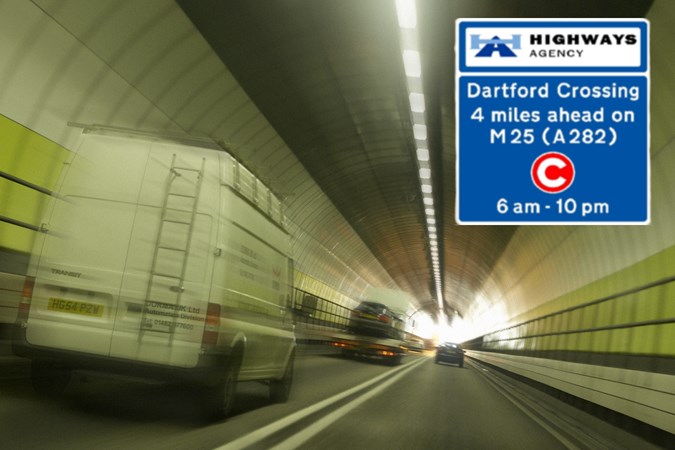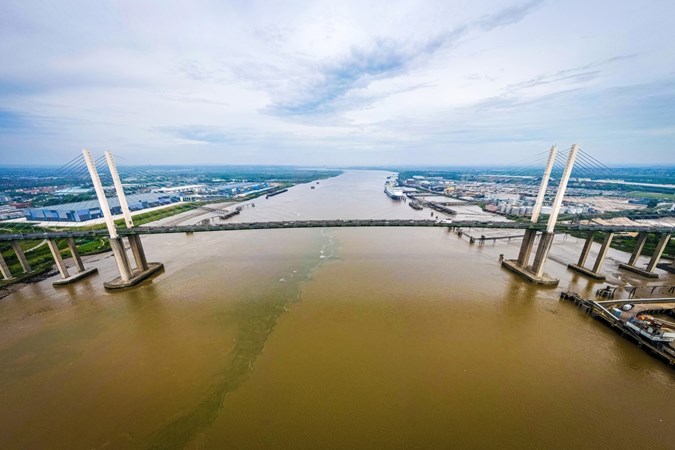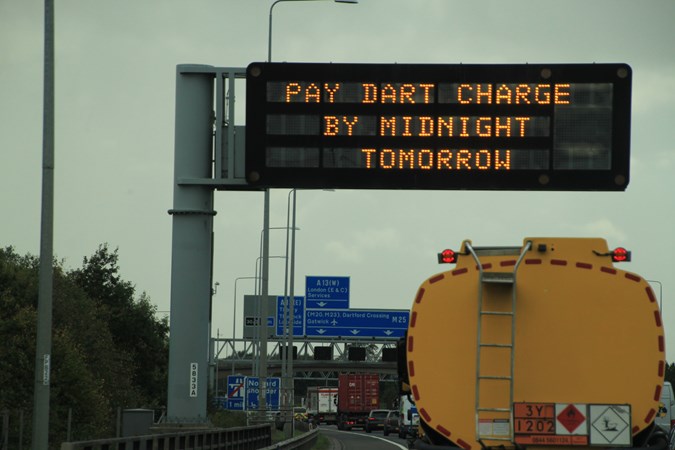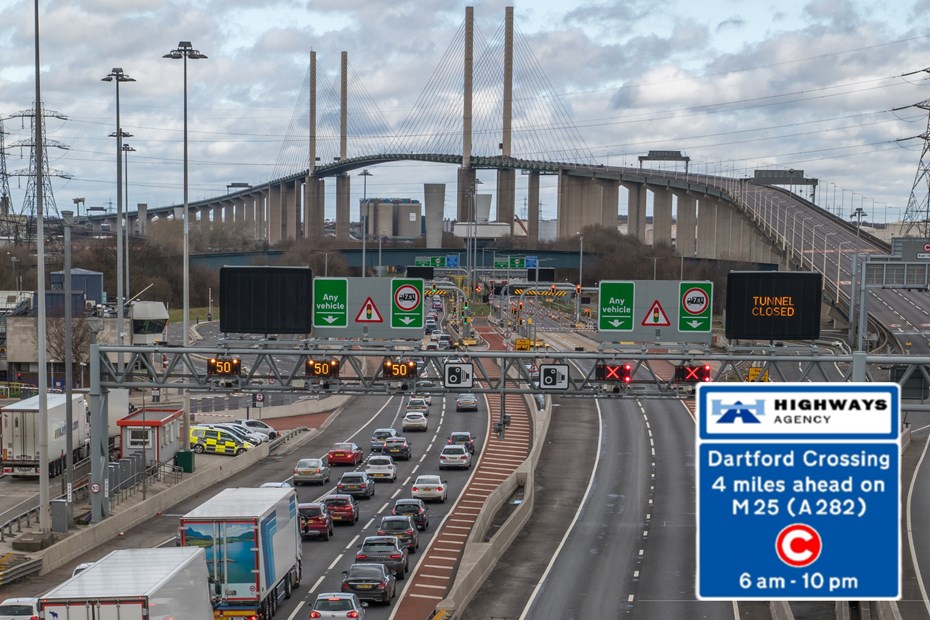The Dartford Crossing toll is a vital connecting road linking Essex and Kent that’s been in place since the 1960s. For most drivers, it’s a necessary and unpleasant addition to the grind of circulating the M25 motorway in the Thames Estuary area – but at least these days, you’re not queuing at a toll booth to pay. Read on to find out how to pay, the cost, and what happens if you don’t cough up.
However that does mean it’s sometimes easy to forget to pay – and we explain how it works later – as it’s automatically charged as you pass through. And with good reason; it’s a charged toll crossing that’s a crucial part of the M25, one that carries over 50 million vehicles every year, including passenger cars, vans, motorcycles, campervans, and heavy-duty commercial vehicles, and delays here can be disastrous.
The crossing consists of the Queen Elizabeth II (QE II) Bridge, which takes drivers south across the River Thames towards Dartford in Kent, while the Dartford Tunnel takes drivers north under the river towards Thurrock in Essex. In its current form, the crossing is designed to carry up to 135,000 vehicles per day, but it has been known to carry up to 180,000 vehicles at its busiest times.
Originally, the Dartford Crossing was a single two-way tunnel located some 20 miles east from the centre of London. The development of the crossing started back in the 1930s, but was put on hold due to the outbreak of the Second World War, before restarting in the 1950s. It opened on 18 November 1963, when the first passenger vehicles passed through the crossing. Back then, it was used by around 12,000 vehicles every day for a toll fee of about 13p – the equivalent of £3 in today’s money.

What is the Dartford Crossing?
Nowadays, the Dartford Crossing toll road consists of a bridge and a pair of two-lane tunnels. The second tunnel was added in the 1970s to allow two lanes of traffic to cross in each direction, rather than one. By the 1980s, the tunnel infrastructure was struggling to cope with the ever increasing number of vehicles, and so the Queen Elizabeth II (QE II) Bridge was built to carry all southbound traffic, leaving the tunnels to handle northbound vehicles.
The bridge was built at a cost of £120 million to cope with the anticipated growth of traffic using the M25 London Orbital. That’s the ring road around the capital, much like the Boulevard Périphérique around central Paris. Coincidentally, one or our writers’ grandfathers was involved in insuring the bridge’s construction.
What junction is the Dartford Crossing?
On the M25, the Dartford Crossing sits between junctions 1A and 31. Technically speaking, the Dartford Crossing isn’t part of the M25 – it’s a separate stretch of road numbered A282. As such, it marks both the beginning and end of the M25.
If you want to avoid taking the crossing travelling southbound, exit the motorway at Junction 30, and take the A13 west into central London or the A13 east towards Stanford-le-Hope and Southend-on-Sea. If you’re travelling northbound, you can leave the motorway before crossing at the Littlebrook Interchange, at Junction 1A.
There are no other vehicle crossings along the Thames to the east; to the west the nearest options are the Woolwich ferry or Blackwall Tunnel.

Is the Dartford Crossing a toll road?
The Dartford Crossing has always been a toll road. The overall cost of construction was around £800 million in today’s money. By charging a fee to use the crossing, the counties it serves have been able to maintain the crossing and pay down the construction costs, which were cleared in 2003.
The Dartford Crossing has since generated £669 million, bringing in staggering revenues of £202.3 million in 2022 alone. Much of that is spent on maintenance and security, but the matter of how to spend the profits has long caused local political disputes. For instance, local MPs have called for investment in alleviating pollution and congestion in the surrounding area.
How much is the Dartford Crossing charge in 2025?
The charge for using the Dartford Crossing is called Dart Charge; it’s different depending on whether you’re making a one-off payment or you’re an account holder, the latter receiving a small discount. Drivers need to pay the Dart Charge for using the crossing between 6am and 10pm every day, including weekends and bank holidays.
In 2024, the fee for a single crossing is £2.50 for cars, £3 for ‘two-axle goods vehicles’ including vans and pickups, and £6 for multi-axle goods vehicles. If you sign up for a Dart Charge account, the cost per crossing is reduced to £2 for cars, £2.63 for ‘two-axle goods vehicles,’ and £5.19 for multi-axle goods vehicles. If you make the crossing on a motorcycle, a moped, or a quad bike, the crossing is free.
How do you pay for the Dartford Crossing?
Dart Charge employs automatic number plate recognition technology that allows drivers to pay before or after a crossing. Head to the Dart Charge website then enter your car and payment details to make a one-off payment or set up an account. You can also pay by phone or at a Payzone terminal.
If you have an account and have registered your vehicle’s number plate to it, automatic payment is deducted from your account balance. That’s means you have to put an amount of in the account to start with, then keep it topped as you use the crossing.
Payments were previously made at toll booths that regularly caused 10-mile tailbacks. Their removal hasn’t entirely alleviated congestion, though, especially heading northbound as traffic funnels into the speed-restricted tunnels.
Do you pay both ways on Dartford Crossing?
Yes, whether you’re travelling north to south – i.e. Essex to Kent – or vice versa. The toll charge you pay only counts for one leg of the journey. Now there are no toll booths, a model called ‘free flow charging’ uses automatic number plate recognition (ANPR) cameras to record the vehicles passing over the bridge, or through the tunnels.
Motorists have until midnight the day after they cross to pay.

What time is Dartford Crossing free?
The Dart Charge doesn’t apply between 10pm and 6am every day of the week. On the approach to the Dartford Crossing, signage states the hours of operation and counts down the distance, giving motorists the choice to take a sliproad and avoid the charge. Those signs show the same red circled ‘C’ as of London’s Congestion Charge,
What is the fine for not paying the Dart Charge?
If payment isn’t made before midnight the following day, you will receive a £35 fine, which itself is only valid for 14 days. If it’s ignored, the Dart Charge penalty doubles to £70. It then climbs to £105 over 28 days.
What happens if I pay Dart Charge one day late?
You have until midnight the day after you’ve used the crossing to pay the Dart Charge. So, if you cross at one minute past midnight, you have 47 hours, 59 minutes to pay – plenty of time to spend a couple of minutes on the website making the payment. Miss the deadline and you face a fine of £35 that must be paid within 14 days.
What happens if the Dartford Crossing is closed?
To protect against accidents during high winds, there is a protocol in place to close the QE II Bridge. If crosswinds are 50mph or more, or headwinds are 60mph, the speed limit for vehicles travelling over the bridge is restricted to 30mph.
If the crosswinds exceed 55mph or headwinds exceed 65mph, lanes are closed based on wind direction. If crosswinds are expected to reach or exceed 60mph, or headwinds to reach or exceed 70mph, the QE II Bridge is closed to all vehicles. At this point, traffic is diverted through the tunnels. The bridge re-opens once the strong winds have passed.
Both the QE II Bridge and tunnels are also closed for scheduled maintenance and routine inspections on certain dates, although typically only one or the other will be shut at any given time to allow traffic to continue making the crossing. Such essential works usually take place overnight, so it’s worth checking before you travel to make sure the crossing is fully operational. Updates on closure times and dates can be found on the National Highways website.
Just so you know, we may receive a commission or other compensation from the links on this website - read why you should trust us.










